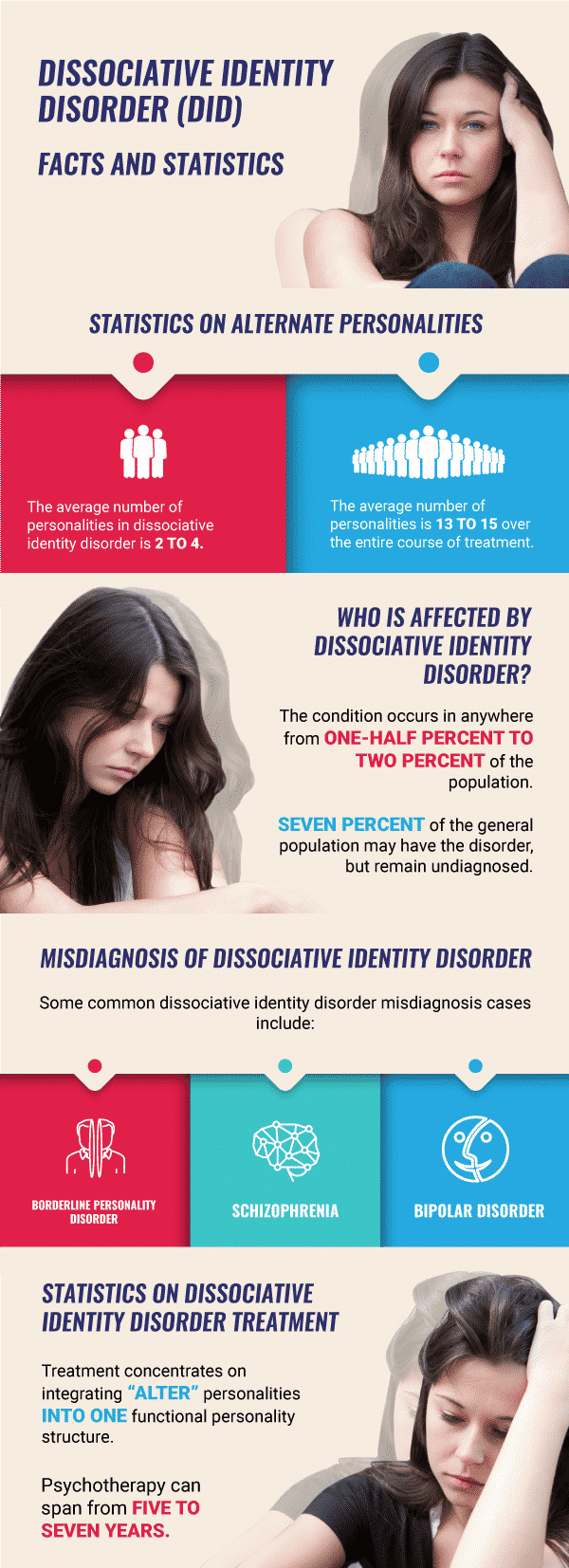Read the latest statistics on dissociative identity disorder and how to get help for this condition.
Dissociative identity disorder, previously known as multiple personality disorder, is a psychological state that is characterized by a disconnect between a person’s thoughts, emotions and behaviors. Dissociative identity disorder is a complicated condition that develops from numerous factors, namely early and severe childhood trauma, abuse and neglect. The dissociative features of the disorder are believed to be used as a complex coping strategy, allowing individuals to separate themselves from past traumatic experiences. These experiences are thought to be too upsetting for people to integrate into their conscious thoughts.
Dissociative identity disorder occurs when two or more separate identities are present, each playing a distinctive role and having control over a person’s actions, memories and feelings. Life experiences and situational factors seemingly trigger shifts between identities.
Conclusive facts and statistics on dissociative identity disorder are not readily available due to lack of research and controversy linked to the disorder. However, available dissociative identity disorder documentation conveys that the disorder was initially believed to be quite rare, with less than 100 diagnosed cases by 1944. Current dissociative identity disorder facts now show that the prevalence of the disorder is beginning to rise, perhaps due to greater understanding and more accurate diagnosis processes.
Treatment Can Be Life Changing. Reach out today.
Whether you are struggling with addiction, mental health or both, our expert team is here to guide you every step of the way. Don’t wait— reach out today to take the first step toward taking control of your life.
How Common is DID?
Dissociative identity disorder prevalence varies widely in different studies. Dissociative identity disorder has been identified in 4 percent to 7.5 percent of patients in psychiatric residences and 2-6 percent of patients in outpatient settings. DID is otherwise very rare, with rates of 0.4 percent to three and one-tenth percent of individuals not linked with mental health services. Dissociative identity disorder is also believed to be widely undiagnosed or misdiagnosed, making it difficult to determine exactly how many people are affected by dissociative identity disorder.
Statistics on DID and Alternate Personalities
Dissociative identity disorders are not overly common, but aren’t entirely rare, either. Statistics on alternate personalities have risen over time, which may come from better knowledge and understanding of the condition along with fewer cases of misdiagnosis.
The average number of personalities in dissociative identity disorder istwo to four upon initial diagnosis. The average number of personalities in someone with multiple personality disorder is13 to 15 over the entire course of treatment. It is unusual, but there have been cases in which more than 100 personalities have been reported.
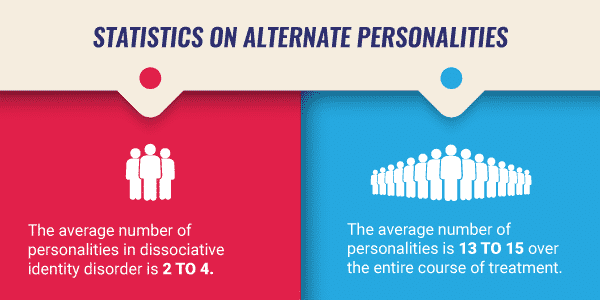
Who Is Affected by Dissociative Identity Disorder?
Dissociative identity disorder statisticsvary but show that the condition occurs in anywhere fromone-half percent to twopercent of the population. Other dissociative identity disorder facts suggest that about seven percentof the general populationmay have the disorder, but remain undiagnosed.
Dissociative identity disorder is a relatively rare and controversial condition, making it complicated to study and research. Researchers continue to assess how common dissociative identity disorder is in the population. Available research indicates that approximatelytwo percent of people in the worldexperience dissociative disorders and they are more commonly diagnosed in women.
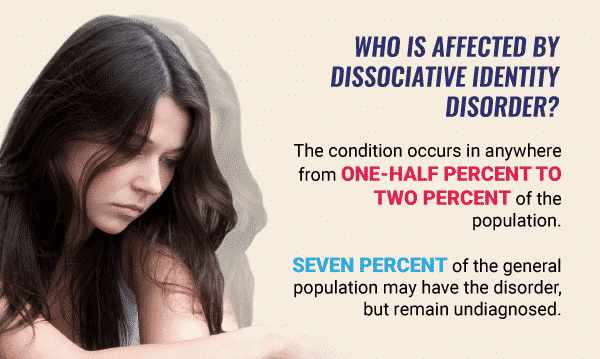
Research has sought to investigate why dissociative identity disorder is more common in females. Studies have found that women have symptoms more regularly than males, as males are more apt to hide symptoms and traumatic histories. Men also display more aggressive behavior and less memory loss than females do, resulting in less diagnosis. Females face childhood abuse more frequently than males, also making dissociative identity disorder more likely to occur in the female population.
Individuals who are victims of past violence and mistreatment are at elevated risk of developing dissociative identity disorder.Dissociative symptomsoriginate to help a person to deal with distressing and traumatic memories.Risk factors for dissociative identity disorderinclude severe abuse, recurrent neglect, natural disasters and past trauma in childhood. In reported cases in the United States, Canada and Europe,approximately 90 percentof people with this condition had experienced abuse and neglect in childhood.
Rates of DID and Substance Abuse
There is a direct relationship betweensubstance abuse and dissociative identity disorder, as people may use drugs or alcohol to numb symptoms and separate from reality. People may use substances as a way to cope with their victimization and past trauma. Individuals with dissociative identity disorder and co-occurring addictions contend with added difficulties on top of original issues that led to the dissociation. Dissociation and addiction are both chronic, recurring conditions that are complex to treat. In one study of people in an inpatient substance abuse treatment program,17.2 percentof people had a dissociative disorder.
Misdiagnosis of Dissociative Identity Disorder
Dissociative identity disorder misdiagnosisis common, as symptoms are similar to symptoms of othermental health disorders. Many psychological conditions share symptoms ofanxiety,depressionandsubstance abuse. Some individuals with dissociative identity disorder may receive several diagnoses before being given a correct dissociative identity disorder diagnosis. To further complicate matters, one personality may present symptoms of a mental health condition that is not shared by the primary “host” personality.
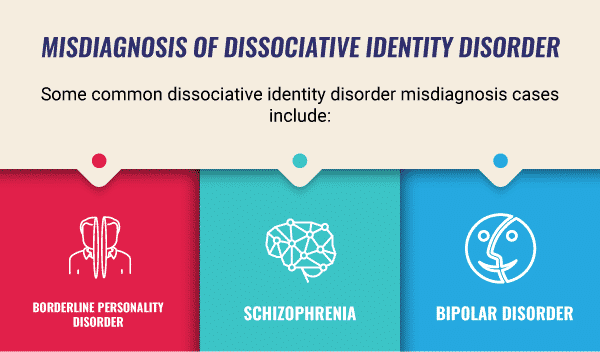
Some common dissociative identity disorder misdiagnosis cases includeborderline personality disorder,schizophreniaandbipolar disorder. It is unclear whether these misdiagnoses arise from actual misdiagnosis or whether these diagnoses are present in conjunction with dissociative identity disorder. Misdiagnosis can result in incorrect treatments, worsening of symptoms or no improvement.
Statistics on Dissociative Identity Disorder Treatment
Dissociative identity disorder treatmentconcentrates on integrating “alter” personalities into one functional personality structure. Dissociative identity disorder recovery is long-term, multi-staged and consists mainly of talk therapy, hypnotherapy and other psychotherapeutic treatment interventions. Medications are not used to treat the disorder itself but may be prescribed to treat specific symptoms.
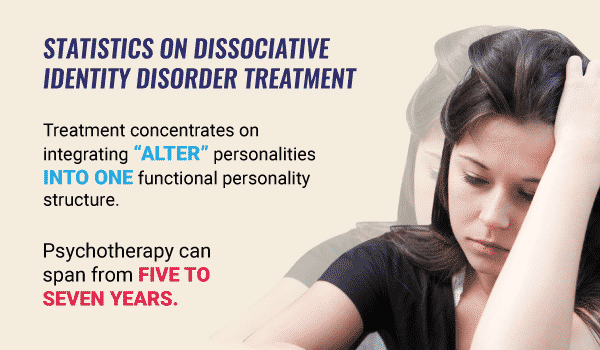
Psychotherapy can span fromfive to seven years. Individuals who do not receivetreatment for dissociative disorderstend to get worse, as alternate personalities cannot integrate on their own. Untreated dissociative identity disorder makes an individual susceptible to further exploitation and mistreatment by others. Typical treatment approaches attempt to stabilize an individual, process trauma and integrate personalities. Although statistics depict that dissociative identity disorder is rare, it is also a commonly misdiagnosed or undiagnosed condition.
Check out the Nobu app to learn more about dissociative identity disorder and a variety of other mental health topics. It is free and for anyone that is looking to reduce anxiety, work through depression, build self-esteem, get aftercare following treatment, attend teletherapy sessions and so much more. Download theNobu apptoday!

